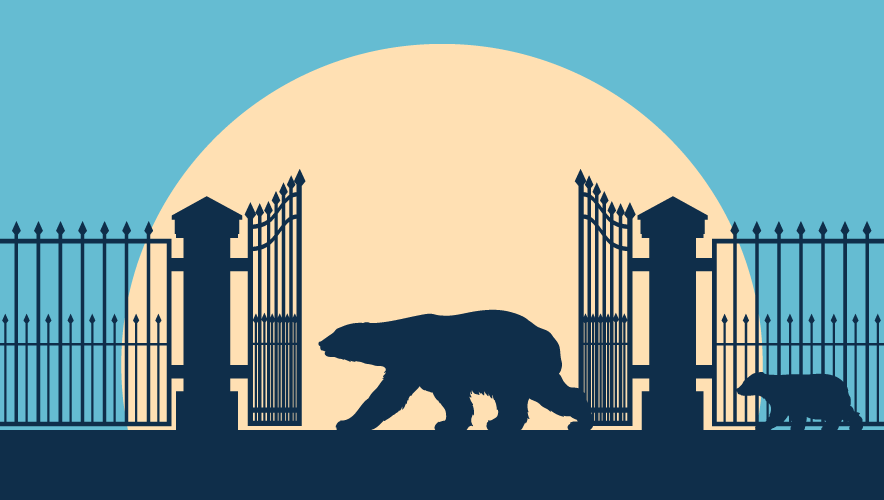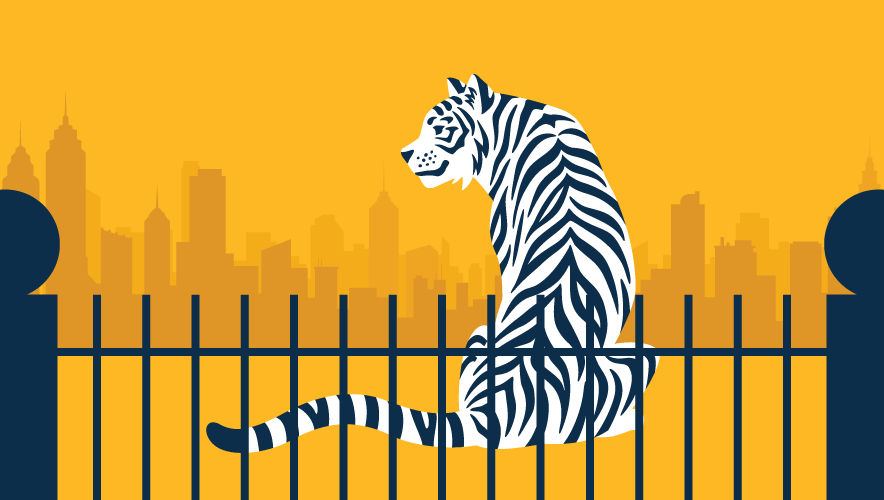Holding the Door: How the Columbus Zoo is Rekeying its Campus
Key management is one of the most unglamorous, yet important aspects of corporate security. It helps practitioners keep track of which locks are paired with which keys, who has access to those keys, and how those keys are used as people move around the facility.
The stakes for key management are even higher for zoos and aquariums, where door locks and their paired keys are designed to limit access to animal enclosures and sensitive holding areas.
“We do have doors that are public-facing that have animal holding areas on the other side—that’s a big concern for us,” says Steven Langton, director of safety and security for the Columbus Zoo Family of Parks, which includes the zoo, an aquarium, Zoombezi Bay water park, and a golf course. “What happens if one of these doors is left unlocked and somebody opens it up, goes inside, and there’s animal A, B, or C on the other side for them to interact with?” Langton continues. “That could lead to complications for the guest, for staff, or for our animals.”
Opened in 1927, the Columbus Zoo is the home of the first gorilla born in professional care and where Jack Hanna, who spread the love of animals through numerous television specials, worked as the director to transform the zoo into an immersive experience for visitors while sharing the importance of conservation efforts. Now the Columbus Zoo and Aquarium welcomes more than 2 million visitors annually to its campus to see the more than 10,000 animals representing 600 species in its collection.
The zoo is one of the largest in the United States with approximately 600 acres of grounds, Langton says. He works with about 25 year-round security team members and then hires approximately 130 seasonal employees to assist during the summer season in North America.
One of the unique security challenges for the zoo is its large perimeter, and it places an emphasis on keeping animals inside this zone using fencing, a requirement under the zoo’s accreditation authority, the Association of Zoos and Aquariums (AZA), Langton says.
“If you look at all of our perimeter fences, they’re all designed to keep animals in—not necessarily people out,” he adds. “That’s a big concern for us from an access point, just to get on grounds.”
Within the zoo itself, there are thousands of doors that are used as access points for public facing services—bathrooms, dining areas, gift shops, meeting rooms, educational facilities, and more—and to sensitive areas that the public should not enter. These include the zoo’s animal hospital where it provides care and conducts research, as well as animal enclosures, holding areas, and caretaker spaces.
To help manage some of these access concerns, Langton’s team has embarked on an ambitious three-year project: rekeying the zoo, Zoombezi Bay, and the golf course.
“Our animal care staff has had a lot of input into this project, helping us plan out and design how their buildings, corridors, and animal chutes—all of those things—are secured so if there’s an emergency, they have everything they need to get themselves to safety,” Langton says. “But at the same time, keep everybody else that shouldn’t have access to those areas away.”
The Original System
The original lock system at the Columbus Zoo was a mechanical lock and key system using master keys. But over time, Langton says he and his predecessor discovered that there was no effort made to track and maintain keys or to maintain a log of the different doors that keys went to. This created a system where everyone just had a master key.
“Over the years, that continued to evolve to where you could have a master key and what we call a 7133—our general gate key—and those two keys could get you into probably 95 percent of the doors and spaces inside the zoo and Zoombezi Bay,” Langton explains. “That was a huge concern, not only that two keys could get you access to everything, but that we had no idea how many of these keys were out there and who had them.”
The zoo has electronic access control at some sensitive locations on the campus—such as the hospital and the cash room. But the mechanical lock and key system used elsewhere was still an issue because there was “no way we can confidently say these areas are secure with all of these keys out there,” Langton adds.
Changing the system, however, would be a major endeavor that would affect day-to-day operations for the entire zoo. Locks and keys for all departments—from animal care to education to ground security to retail to food and beverage—would need to be reassessed. And security would be taking the lead.
Planning the Upgrade
Langton says the team started looking at the zoo’s departments and identifying who would need access to certain areas of the zoo and who should have more limited entry rights. To get buy-in, the security team went around to the rest of the zoo staff, speaking with curators of every department and reviewing the floor plans for their buildings and offices.
They asked department leads to review the plans door-by-door and assess: What makes sense for this area? Who should have access? Who do you not want in this area? Asking individual leads was important because each area of the zoo had different requirements, Langton says.
“In our North America region, where we have a lot of dangerous animals like bears, polar bears, wolves, and cougars, they wanted it restricted to where only North America animal keepers could get into those animal species, which makes complete sense,” Langton explains. “Back in our Congo area, where they have a lot of primates and things like that, they wanted the ability for not just their animal care team but also our maintenance team to get inside some of their spaces.”
Having this level of access in the Congo area was important for emergency response. If a fire, flood, or other incident occurred, maintenance staff would not be forced to wait for an animal care person to let them inside—potentially delaying care to animals.
“It’s a very detailed process where we tried to get input from everybody we could,” Langton says. “There were some places where security trumped what their recommendations were because the security concern was a larger piece than maybe a minor inconvenience to them. But for the most part, we took feedback that everybody provided and tried hard to work that into the plan to make it a good middle ground for everybody.”
Key to this process was working with the locksmith company, the Carl Zipf Lock Shop, which the zoo had an existing relationship with and had previously worked on rekeying schools, prisons, and small cities. The company helped Langton decide how to approach a structured rekeying at a major campus.
The locksmith surveyed the entire property over several weeks, reviewing each door and opening, as well as standing in during meetings with the curatorial staff.
“They gave us a good point to jump off from as far as things we should be looking at while we’re greatly increasing security, while also keeping that convenience that’s needed for employees to get around and do what they need to do,” Langton adds.
The locksmith team also educated the security team on how lock and key systems really work, including master key systems, by providing diagrams and schematics.
For instance, they showed how a master key could unlock a certain lock but underneath that master key there would be multiple sets of change keys—per building or per office—that could not interact with each other.
“That makes sense, but when you’re talking about thousands of doors and a hundred buildings, trying to visualize that on a grand scale and how everything fits together, that’s really where they were invaluable,” Langton says.
After assessing access needs, the zoo also had to choose a new lock and key style. It decided to go with a familiar brand—Schlage—to create a high-security master key system that prevents individual keys from being copied.
“Because of the way they’re cut and designed, you can’t take them to Lowe’s [Home Improvement store] or to somebody else and copy keys,” Langton says. “We have to order key blanks directly from the factory. And there are only certain people here authorized to do that on behalf of the zoo. They ship us the key blanks directly, and then we have them cut to what we need.”
Another benefit of going with the Schlage locks is they use a large format interchangeable core—the part of the lock where you insert a key in the door hardware. This means that if a door isn’t operating correctly, the zoo has the option of removing the core and replacing it with a back-up.
“That helps us, too, if we ever need to rekey something or secure something separately, we can simply go there, change out the core, and it’s going to require a whole different key set or key to get into that space,” Langton explains. “That just gives us an advantage when we need to secure something or change something out.”
The interchangeable core feature also helped contain costs and initiated a system where keys will now be serialized on sealed key rings, so the zoo can track who has which key.
“Then if somebody loses a key or something happens, and we need to rekey things, we know exactly what everything’s keyed to,” Langton says. “Instead of having to switch out a bunch of hardware and different things, we can just go pop cores out, put new ones in, and again, very little downtime. Very little inconvenience to our staff to make that happen.”
The Schlage locks are distributed by Allegion, which devoted time and staff power to surveying the zoo to design a key management system.
“We told [Allegion] our requirements, they helped design the schematics and how everything should be broken down,” Langton says. “They’ve [Allegion and Carl Zipf] been really invaluable to getting this project off the ground.”
The zoo is now using Schlage’s computer-based system called SiteMaster to manage its keys. Langton explains that it was purchased in preparation for the project to track keys, who they are issued to, and all the hardware on doors throughout the campus—down to the hinges.
“If something ever breaks, we know automatically that the hinge broke on door number 3 of building 315,” Langton says. “We know exactly what those hinges are, we can order them without even going to look at the door and have them enroute to have them replaced as quickly as possible.”
The Install Process
Langton’s team is working to replace approximately 1,500 sets of hardware on doors throughout the zoo, Zoombezi Bay, and golf course campus. The ordering, staging, and installation process for a project of this scale was daunting.
All the materials were ordered and delivered over the course of two to three weeks. Roughly 23 pallets of hardware, keys, and equipment were placed in one of the zoo’s event spaces.
“Our locksmith team has been separating everything in regions by building by door to make it easy for their technicians to come in, grab stuff, and go and start installing,” Langton says.
The installation began in March 2024 with the Zoombezi Bay waterpark, which was closed until the summertime in North America. Each lock takes about 20 to 25 minutes for tear out and then hardware installation. Then, technicians will transition to install the new hardware at the front and gate entry plaza area—guest relations, ticket windows, parking booths, retail, and food and beverage. The goal is to have the entire installation completed by the third quarter of 2024.
“The intent there is that once we hit summertime, really Memorial Day, it gets much, much busier up there than it is now,” Langton says. “We’re trying to knock out those areas where the guest count is going to increase the further along we get, so it makes sense from our standpoint to knock that out first while we’re still a little bit slower.”
After the waterpark, attention will shift to the zoo. The teams will work with the individual animal departments to determine a schedule for replacing the locks that works best for them and the animals in their care. Most zoos provide holding areas for animals—private areas, indoor exhibits, outdoor exhibits, or off-exhibit living spaces. Animals are used to moving into these different spaces based on their needs, as well as cleaning and care schedules.
But there are some spaces where technicians will have to hold off for circumstances beyond humans’ control.
“There’s areas we can’t go into because maybe they’re waiting on penguin eggs to hatch or some other animal to give birth,” Langton says. “We’re not going to go in and disturb that to switch out some locks and keys. That’s really what’s going to drive how we move after the non-animal areas.”
Technicians will be escorted when working in the more sensitive areas of the zoo, such as the hospital and any animal care areas. This will also require communication and coordination about how to handle access should an emergency occur while locks are being installed.
“The big piece is just having a support team there with them to help through those processes, so technicians don’t have to worry about what to do in an emergency or if we have to quickly shut something down or move something,” Langton adds.
Along with the locks and door hardware, the zoo is also switching out about 1,000 padlocks it uses around the property and creating a separate keying system for dangerous animal padlocks. Most of these areas are on a two-lock, two-key system.
“Every door and chute, all those things, is secured by two locks and then two different people hold the keys to those locks,” Langton says. “It’s a safety measure to make sure one person doesn’t allow an animal into an area where it shouldn’t go or to where there’s somebody in there.”
The padlock switch will begin after the door locks are changed, but it will utilize a similar high-security master key system.
“But on a different keyway from the one we’re doing now, just to make sure there’s no crossover in between what leads to a dangerous animal and what leads to the gift shop,” Langton says.
After replacing the hardware, the zoo will recycle the old materials—keeping in line with its commitment to conservation and sustainability. Currently, they are working to identify an appropriate recycler.
“Being that one of our major missions here at the zoo is conservation and sustainability, it made sense from our standpoint then to just recycle it and get it all taken care of,” Langton says.
Parting Advice
For security practitioners embarking on their own rekeying project, Langton says he recommends finding a locksmith company that you are comfortable with and trust.
When he and his predecessor began this rekeying project three year ago, they had an idea of what they wanted and the direction they wanted to go in. But after speaking with folks they knew and trusted—including the locksmith team—they realized they were off the mark.
“A lot of it is just not knowing and understanding the grand scheme, and how to get everything to work together but still be separate and secure,” Langton says. “That’s where companies like Allegion and our locksmith company have proven themselves invaluable.”
It’s also critical to have buy-in from the organization to embark on a project like this, which is expensive and inconvenient because you’re changing the way that people have accessed the facility to do their jobs—especially with the move to sealed key rings, he explains.
“It’s going to be inconvenient for a while until they learn the new system of what keys go to what doors, and where they’re at on their key rings,” Langton says. “Having that organizational buy-in is super important.”
Megan Gates is senior editor at Security Management. Connect with her at [email protected] or on LinkedIn. Follow her on Threads or X: @mgngates.











